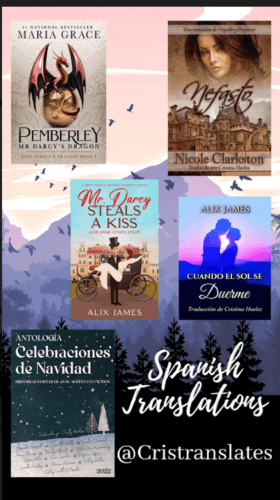Can Dragons Speak Spanish?

Today is International Translation Day, which is great, but let me ask you, do you know why September 30 is International Translation Day?
It is the Feast Day of St. Jerome, the patron saint of translators! He is best known for his translation of the Bible from its original languages into Latin.
In honor of Translation day, I’d like to introduce Cristy Huelsz who is finishing up the translation of Pemberley: Mr. Darcy’s Dragon into Spanish.
I am so excited about this project!. A large part of my family are Spanish-speaking and I haven’t been able to share my stories with them until now. Sadly, my own command of Spanish is rudimentary at best, and will never be at the level required for a task like translating a novel, even one that I wrote!
There’s an old saying that “Translation is Treason'” because of the incredible difficulty of accurately translating the words AND meanings of one language into another. I’ve asked Cristy to joins us today and give us some insight on the complexities of giving Blue Order Dragons a second language.
But first, Cristy, can you tell us a little about yourself and what made you decide to go into translation professionally.
Some years ago, I was teaching English in Mexico to kids and adults. I liked my job but there was a moment in which I started to look for something else. While reading The Man Who Loved Jane Austen by Sally Smith O´Rourke in 2017, I noticed that many of my favorite books were not translated into Spanish. What I did first was to ask an author if I could translate her book. She kindly gave me the opportunity to translate the first chapters. I did it, send it, but there was no editor interested.

At that time, I really knew very little about what translation is actually, or how it works.
I was lucky to find a diplomado (a course of short or medium duration (80 to 120 hours), generally given by a university or institution of higher education, which has the purpose of teaching, complementing or updating some specific knowledge or skill) by the University of Guanajuato. That diplomado showed me a whole world of translation and interpretation. But I needed more. Shortly after, I was really happy finding that there was a specific online diplomado for book translation by AMETLI (Mexican Association of Literary Translators). This one was about 2 years of intense classes of linguistics, morphology, grammar in Spanish and English, literary analysis, research, subtitles, copyrights, etc.
It was during that course that I found the JAFF community. Nicole Clarkston kindly gave me the opportunity to start working with JAFF authors. So far, I have worked with 10 novels.
Is working with authors directly different than working with a publisher?
There is a big difference between how I work and how my colleagues who are with a publishing house work. When a publisher acquires the rights to a book for translation, the translator will spend at least 6 months on it. The translation will go through revisers, editors, proofreaders. The author will not know anything about the book until it is published the following year.
What I do is work directly with the authors. Either they hire me, or I make them a proposal to translate their book. We sign a contract and for about 4 to 5 months I am in contact with the author to clarify doubts, to know exactly what they were referring to in a certain line, references to poems, if they are using a passage from Austen’s novels, and so on. Last year, I started working with the amazing Belen Paccagnella as my proofreader and colleague, so I can assure my authors that the translation is thoroughly reviewed.
In this day of AI (artificial intelligence) and things like Google Translate, why do we need translators instead of just using the computer to do it for us?
AI is a big topic for us. Some AI might be able to translate faster than a person, but there is no way a machine can understand the meaning of a sentence by reading between the lines, making an interpretation of the author, being able to infer what a character is really saying through satire, having the reference that came out in the previous book, and other examples of the translation that we people manage to do thanks to the enormous and continuous amount of reading, consulting dictionaries, reading the same sentence 5 times, correcting the whole text more than once, being able to be faithful to the author’s style.
That echoes a lot the concerns I have had about using AI tools in my own work. They do some things well, but the higher-levels skills still require the human touch. What sort of problems do you see happening with AI translation?

Machine translation uses of either rule-based or probabilistic (i.e. statistical and, most recently, neural network-based) and it´s more than 50 years old. Google translation is not the best, as it translates word by word, not by context, so the text that you might be trying to translate is going to have many mistakes and it might not make sense.
And the big problem with these AI is that more people are trying to do our job, but they know nothing about translation. They might know English -or other languages- but don´t know about linguistics, grammar, syntax, equivalence, false friends. As translators we are not just bilingual but bicultural. These kind of issues are similar to when -without authorization, making changes to the story- Isabelle de Montolieu “translated” into French Sense and Sensibility in 1815.
What do human translators do differently that avoids the problems that AI translation have?
I read many times the text, I’m in contact with my authors, I use references from other books, I research in dictionaries, I read all the time, I only use 1 translation machine when I have some difficult sentences, I ask to my colleagues, etc.
What made you want to translate Pemberley into Spanish?
When I saw that there was a book about Austen and dragons, I thought it was just the thing that our Spanish speaking readers needed to read. Because somehow it´s something different to many fantasy JAFF novels and a story of Elizabeth saving the day and being recognized for it is awesome.
What challenges did you face in translating fantasy? I have to imagine the dragon elements were particulary tricky.

It was quite a challenge because it´s my first fantasy novel. Many of the dragon types do not have a direct translation, or if translated, the essence of the name is somewhat lost, as it happens with firedrake. In Spanish it is ‘dragon of fire’, but we agree that there is more than one fire-breathing dragon. So, the biggest issues were dragon types, the Blue Order vocabulary, and the dragon folk. Curiously, we have wyvern as a ‘guiverno’, but I decided not to use it. In Spanish it is common that the wyvern is simply called a dragon, when we know that there is a difference in the number of limbs.
Although in the translation of fantasy is common to invent names/words, or just translate it to the closest meaning, I decided to leave some words as they´re in English because I really like how they sound and their meaning.
What strategy did you use to overcome these hurdles?
I read the book a couple of times, asked the author, searched in dictionaries, took references from The Hobbit, Eragon and other dragon books, and made a lot of decisions. A big part when we are translating is to make choices of which word is better, if this or that translation has more meaning, if I need to add some explanation to some words which are unknown in the target language.
I´m a great fan of fantasy. I read Lord of the Rings -the three books- just a few months before the first movie came out. I had the pleasure of being invited by Abigail Reynolds to work with her and other authors on her weekly publication last year of Mr. Darcy and the Enchanted Library, and I really liked working with Pemberley, because it´s one of my favorite types of books.
What have you learned in the process?
That there are many times in which choosing the rights terms for fantasy can help for the imagination of the readers. That you learn new words, terms and translations every book. That each author, even in the same genre, like JAFF, have such different writing styles.
What are you hoping for in the future of your translation work?
I hope this project will open the doors for more translations, that maybe next year I won’t take too many works at the same time, and that I will have the opportunity to go to my first JASNA AGM in Denver and present a little bit of my work at the emporium.
Thanks for joining us today Cristy! I can’t wait for the release date of Pemberley, el dragón del señor Darcy!
You can find Cristy at Blog – Cris Translates
Facebook: @Cristranslates
Instagram: @Cristranslates89

Wonderful! Congratulations, Cris!
Thank you for this, Cristy. Having done a little translation myself, and knowing someone doing PhD work in machine translation, I really enjoyed seeing your take on the challenges of translating these books.
Pingback:Translation Day Sale - Random Bits of Fascination